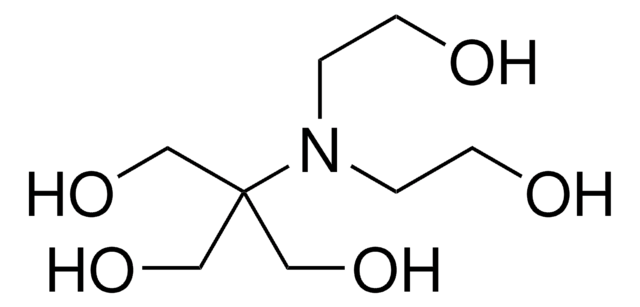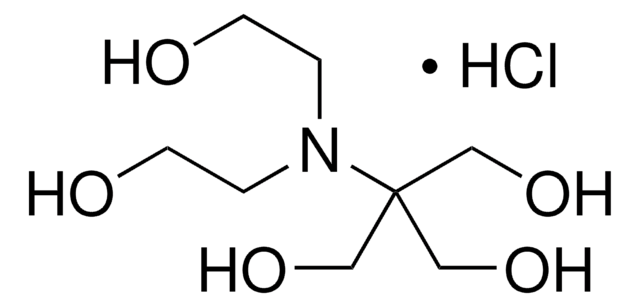14879
BIS-TRIS
BioUltra, ≥99.0% (NT)
Sinonimo/i:
2,2-bis(idrossimetil)-2,2′,2″-nitrilotrietanolo, 2-bis(2-idrossietil)ammino-2-(idrossimetil)-1,3-propandiolo, Bis(2-idrossietil)ammino-tris(idrossimetil)metano
About This Item
Prodotti consigliati
Nome Commerciale
BioUltra
Livello qualitativo
Saggio
≥99.0% (NT)
Stato
powder
Impurezze
insoluble matter, passes filter test
Residuo alla calcinazione
≤0.3%
Perdita
≤0.5% loss on drying, 20 °C (HV)
pH
9.5-11.0 (25 °C, 1 M in H2O)
Intervallo di pH utile
5.8-7.2
pKa (25 °C)
6.5
Solubilità
H2O: 1 M at 20 °C, clear, colorless
Anioni in tracce
chloride (Cl-): ≤50 mg/kg
sulfate (SO42-): ≤50 mg/kg
Cationi in tracce
Al: ≤5 mg/kg
As: ≤0.1 mg/kg
Ba: ≤5 mg/kg
Bi: ≤5 mg/kg
Ca: ≤10 mg/kg
Cd: ≤5 mg/kg
Co: ≤5 mg/kg
Cr: ≤5 mg/kg
Cu: ≤5 mg/kg
Fe: ≤5 mg/kg
K: ≤50 mg/kg
Li: ≤5 mg/kg
Mg: ≤5 mg/kg
Mn: ≤5 mg/kg
Mo: ≤5 mg/kg
Na: ≤50 mg/kg
Ni: ≤5 mg/kg
Pb: ≤5 mg/kg
Sr: ≤5 mg/kg
Zn: ≤5 mg/kg
Assorbimento
cut-off at 270 nm in H2O at 1 M
λ
1 M in H2O
Assorbanza UV
λ: 280 nm Amax: 0.1
Stringa SMILE
OCCN(CCO)C(CO)(CO)CO
InChI
1S/C8H19NO5/c10-3-1-9(2-4-11)8(5-12,6-13)7-14/h10-14H,1-7H2
OWMVSZAMULFTJU-UHFFFAOYSA-N
Cerchi prodotti simili? Visita Guida al confronto tra prodotti
Applicazioni
Altre note
Avvertenze
Warning
Indicazioni di pericolo
Consigli di prudenza
Classi di pericolo
Eye Irrit. 2
Codice della classe di stoccaggio
11 - Combustible Solids
Classe di pericolosità dell'acqua (WGK)
WGK 2
Punto d’infiammabilità (°F)
Not applicable
Punto d’infiammabilità (°C)
Not applicable
Dispositivi di protezione individuale
dust mask type N95 (US), Eyeshields, Gloves
Scegli una delle versioni più recenti:
Possiedi già questo prodotto?
I documenti relativi ai prodotti acquistati recentemente sono disponibili nell’Archivio dei documenti.
I clienti hanno visto anche
Il team dei nostri ricercatori vanta grande esperienza in tutte le aree della ricerca quali Life Science, scienza dei materiali, sintesi chimica, cromatografia, discipline analitiche, ecc..
Contatta l'Assistenza Tecnica.





